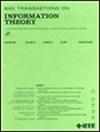单向通信辅助下有限复合源的常见随机生成
IF 2.9
3区 计算机科学
Q3 COMPUTER SCIENCE, INFORMATION SYSTEMS
引用次数: 0
摘要
我们研究了在速率有限的完美信道上,借助单向通信从有限复合源生成共同随机性(CR)的问题。通信双方观察一个有限复合源的独立同分布(i.i.d)样本,目标是对每一个可能的状态达成一个高概率的共同随机变量。双方都知道源状态集及其统计信息。然而,他们不知道实际的状态。我们建立了信道上存在通信的复合CR容量的单字母公式,并研究了复合CR容量的关键性质:超可加性、凹性和连续性。我们还考虑了终端之间没有通信的情况,并且只有在完美信道的接收端终端观察到的源输出是状态相关的。在这种情况下,我们在复合CR容量上建立单字母界限。单字母下界是在所有状态的源分布成对不同的假设下推导出来的。最后,在相同的设置下,我们提出了一个两状态二进制源示例的CR生成方案。值得注意的是,该方案不依赖于前面提到的假设。本文章由计算机程序翻译,如有差异,请以英文原文为准。
Common Randomness Generation From Finite Compound Sources Aided by One-Way Communication
We investigate the problem of generating common randomness (CR) from a finite compound source aided by unidirectional communication over a rate-limited perfect channel. The two communicating parties observe independent and identically distributed (i.i.d.) samples of a finite compound source and aim to agree on a common random variable with high probability for every possible state. Both parties know the set of source states as well as their statistics. However, they don’t know the actual state. We establish a single-letter formula for the compound CR capacity in the presence of communication over the channel and study key properties of the compound CR capacity: super-additivity, concavity, and continuity. We also consider the case where there is no communication between the terminals, and only the source outputs observed by the terminal at the receiving end of the perfect channel are state-dependent. In this setting, we establish single-letter bounds on the compound CR capacity. The single-letter lower bound is derived under the assumption that the source distributions are pairwise distinct for all states. Finally, within the same setting, we propose a CR generation scheme for a two-state binary source example. Notably, this scheme does not depend on the previously mentioned assumption.
求助全文
通过发布文献求助,成功后即可免费获取论文全文。
去求助
来源期刊

IEEE Transactions on Information Theory
工程技术-工程:电子与电气
CiteScore
5.70
自引率
20.00%
发文量
514
审稿时长
12 months
期刊介绍:
The IEEE Transactions on Information Theory is a journal that publishes theoretical and experimental papers concerned with the transmission, processing, and utilization of information. The boundaries of acceptable subject matter are intentionally not sharply delimited. Rather, it is hoped that as the focus of research activity changes, a flexible policy will permit this Transactions to follow suit. Current appropriate topics are best reflected by recent Tables of Contents; they are summarized in the titles of editorial areas that appear on the inside front cover.
 求助内容:
求助内容: 应助结果提醒方式:
应助结果提醒方式:


